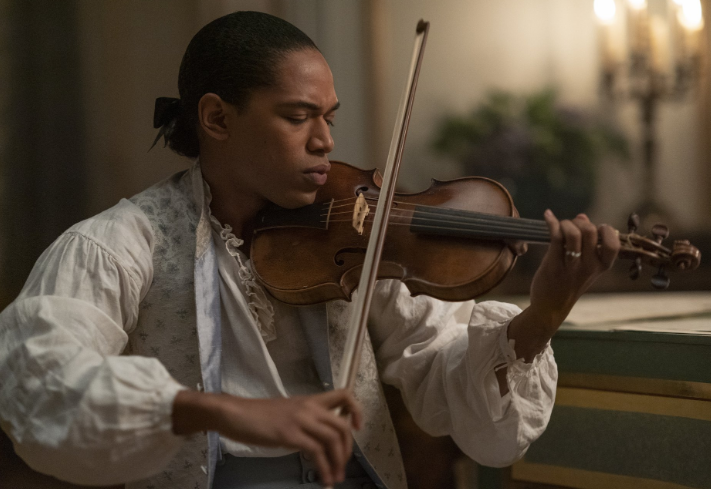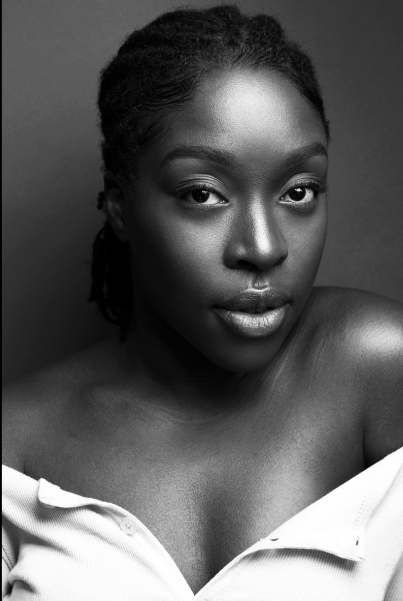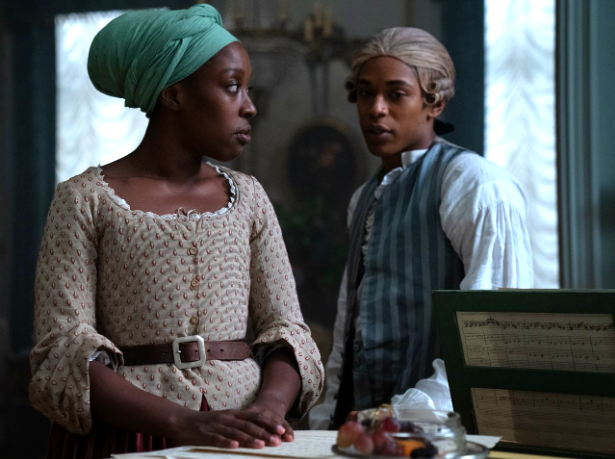Ronkẹ Adékoluẹjo and Kelvin Harrison Jr. in the film “Chevalier.” (Larry Horricks/Searchlight Pictures)
In the recently released film “Chevalier,” Kelvin Harrison Jr., masterfully embodies fencer, violinist, and revolutionary Joseph Bologne, Chevalier de Saint-Georges.
Born on the island of Guadeloupe in 1745, Bologne was the illegitimate son of a plantation owner and an enslaved Senegalese woman named Nanon. At the age of seven, Bologne’s father enrolled him in school in France where he quickly outpaced his peers academically, as well as in the areas of competitive fencing where he won various high-stakes duels.
Upon graduation from France’s Royal Polytechnic Academy of Weapons and Riding in 1766, King Louis XV made Bolonge an officer in the court. He was subsequently known as “Le Chevalier de Saint-Georges.”
 Kelvin Harrison Jr. as Joseph Bologne, Chevalier de Saint-Georges in the film “Chevalier.” (Larry Horricks/Searchlight Pictures)
Kelvin Harrison Jr. as Joseph Bologne, Chevalier de Saint-Georges in the film “Chevalier.” (Larry Horricks/Searchlight Pictures)
Bologne would go on to excel in the realm of music as a pianist, violist, and composer. While often referred to as “The Black Mozart,” it’s said that several of Mozart’s works were inspired by Bologne’s melodies. Bologne served as a musical director for several theaters in addition to being the personal music teacher of Marie Antoinette, a relationship dynamic that is a major aspect of the narrative in “Chevalier.”
Related Stories
Kenny Gravillis: The Art of Visual Storytelling!
‘A Thousand and One’ – A Great First Film by A.V. Rockwell
Though “Chevalier” isn’t a “White savior” movie, it is “White-centered.” Initially, it’s understandable because Joseph’s talent and being of mixed race afforded him access to the upper echelon of society. At the time, he was most likely the only Black man with the same ranking/social status as his Caucasian counterparts.
Moreover, the film ends at the point in which he falls out of favor with Marie Antoinette and the mention of his participation in the French Revolution is a mere footnote at the end of the film.
“Chevalier,” written by Stefani Robinson and directed by Stephen Williams, would have felt like a fuller, more complete film had the audience had the opportunity to see Bologne’s experiences as the leader of the Black Battalion with the 800 soldiers he led into The French Revolution.
The film does show glimpses of Bologne’s interaction with other Black people by introducing his mother, Nanon, into the film. Nanon’s presence grounds Bologne. She is the voice of reason and provides her son with a necessary reprieve, the ability to literally take his wig off and be his full authentic self.
The Sentinel speaks with English actress Ronkẹ Adékoluẹjo about her experience on the set of “Chevalier” which was filmed on location in the Czech Republic.
 One of the first Black composers, Joseph Bologne, Chevalier de Saint-Georges (1745 – 1799)
One of the first Black composers, Joseph Bologne, Chevalier de Saint-Georges (1745 – 1799)
L.A. Sentinel: In addition to “Chevalier” being inspired by a true story, what was it about the script and character that resonated with you?
Ronkẹ Adékoluẹjo: Nanon’s undeniable, ‘I will see my son again’ resilience. There’s just something about women that don’t quit. And Nanon doesn’t stop, she has to get to him and there’s the understanding that he needs her and then her desires of needing him. I tapped into that resilience. That absolute, “I will not take no for an answer.” That’s what drew me to her and also, there’s a softness in her strength. She’s survived so much but she still manages to offer so much love, care, and affection to Joseph even at times when he’s been standoffish.
LAS: There’s a powerful scene in the film where Nanon tells her son that he’s merely a tourist within the aristocratic society. Have you ever felt out of place like you had to prove yourself in a professional setting?
RA: Absolutely. Sometimes, more often than not, especially in the UK industry in the sense that the people who are writing the parts for you don’t necessarily come from your background so you’re reading [scripts]like ‘how am I supposed to portray this? Or you’ve “mammyfied” the character or “best friended” her. One thing I can say with this job [filming “Chevalier”]is this group of people, these creatives, it instantly felt like home. I felt like I was seen, heard, and loved instantly from the jump. If we had time travel, I would go back in a heartbeat! (Laughs)
LAS: In reading various historical articles about Nanon, she’s always referred to as one of the most beautiful women in the West Indies. Is there anything else that you learned that you wish we could have seen in the film?
RA: Well factually, Nanon actually went to France with Joseph and his father because of the father’s affinity for her. But there’s danger in being that beautiful in this sense that people can take ownership over the idea of you. So, what I really enjoyed about Stefani Robinson’s script was that she [Nanon] wasn’t there in the beginning. There wasn’t this idea that was still enslaved when she came to France, she was free and free by choice. I always make up secrets about my characters and give them a bit of spice. For Nanon, my secret was that she got rid of his father to reunite with her son, which allowed her to take back control of her life. Nanon was ferocious, formidable, loving, and caring but you can’t mess with her which is who I want to be in life.
 Ronkẹ Adékoluẹjo (Courtesy photo)
Ronkẹ Adékoluẹjo (Courtesy photo)
LAS: Has “Chevalier” inspired you to direct or produce any other period pieces about unsung historical figures?
RA: There is a woman from the 1800s named Nana Yaa Asantewaa, who fought off the British in Ghana for as long as she could when they came to steal the Golden Stool which was a very sacred stool to the Ashanti tribe. She led the men and women in the war similar to “The Woman King.” She’s so inspiring because she refused to allow their culture to be taken from them.
I’ve had so many serious, heavy roles and I’m thankful but I’m also ready to explore, I’d like to do more action projects and blow things up! With “Chevalier” being a period piece, Nanon is a lot older than I am in reality, so it allows me to show a lot of range. Hopefully, when people Google me, they’ll be able to see that I can do it all.



